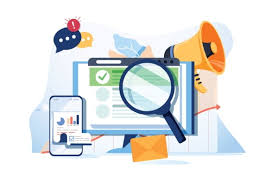Hello!
 In the current world, developing a web site is among the most essential measures towards small business achievement. It is the essential foundation to construct an internet presence and develop your company.
In the current world, developing a web site is among the most essential measures towards small business achievement. It is the essential foundation to construct an internet presence and develop your company.
If folks visit your website, you may potentially find out more about these, and you may turn them in to an urge, spouse, or customer. If one of these things occur, it is a triumph. Now, how can you get traffic to your site?
Employing Mailchimp’s all-in-one advertising platform, you are able to easily market your site across all of your marketing channels. Try out these 5 strategies to drive traffic.
Top 5 Ways to Promote Your Website and Grow Your Business
1. Optimize your website for organic search
 Many business relationships are framed after someone types a word or phrase into a search motor to discover a website. That’s organic search at work. At the point when you realize the search terms individuals use to discover your website as of now, it’s easier to draw in more visitors.
Many business relationships are framed after someone types a word or phrase into a search motor to discover a website. That’s organic search at work. At the point when you realize the search terms individuals use to discover your website as of now, it’s easier to draw in more visitors.
These terms may be explicit to you, for example, a brand or item name. Or on the other hand, they can be attributes or advantages like “all natural,” “free conveyance,” or something different that separates you.
In Google Analytics, you can see what terms your website visitors have used to discover you in the past, and utilize those catchphrases to assist you with enhancing your website content. It can also be enlightening to take a gander at the terms your competition utilizes on their websites, in social media, or in emails.
“The keywords you center around ought to be the regular words a person would utilize,” says Wade Burrell, Senior Product Marketing Manager at Mailchimp. “Consider how your customer would depict your business and what you offer in plain, straightforward terms. At that point, make sure those words are utilized all through your website.”
Google Search Console is another free tool you can use to perceive how frequently your website appears in search results, which search terms drive the most visitors, and the number of individuals click on your site in search results.
Do this, and you’ll be on your way to search engine optimization (SEO).
 These tips can assist you with accomplishing your best work:
These tips can assist you with accomplishing your best work:
- Make your website findable. Be certain your site has careful descriptions of your contributions and their advantages, so that search motors like Google and Bing can surface them. Also, create a spellbinding SEO title for your website. This can be added as you assemble your website and gives one all the more way to individuals to discover you.
- Leverage your website content. Blog entries, articles, audience testimonials, and other content improves your search rankings and carries visitors to your website.
- Improve your visuals. While search motors are greatly improved at ordering words than visual components, images and recordings can help support your Google ranking on the off chance that they’re enhanced for review on cell phones. And, make sure every image incorporates short alt text depicting the image to give the search motor a content alternative to decipher.
2. Greet visitors with a targeted landing page
 Guiding a website visitor to a dedicated landing page featuring exactly what they’re keen on assists them with engaging with your website and, ultimately, your business. Use audience data to create pages that feature content tailored to website visitors’ needs. This may be a special promotion based on the posts someone’s been reading, or updates on new features of an item they’ve been researching.
Guiding a website visitor to a dedicated landing page featuring exactly what they’re keen on assists them with engaging with your website and, ultimately, your business. Use audience data to create pages that feature content tailored to website visitors’ needs. This may be a special promotion based on the posts someone’s been reading, or updates on new features of an item they’ve been researching.
You can incorporate this personalized messaging into your ongoing marketing by creating tags for your contacts.
A tag is a label for a contact which can advise the content you present when they visit to guarantee that it’s relevant.
In the event that you assemble a landing page with an information exchange structure, you can create a tag for that page, so everyone who joins your audience there is tagged for future personalized email outreach. Tags assist you with sending targeted emails, including everything from automated welcome emails for new endorsers of a progression of campaigns that feature connects to content on your website.
3. Promote your site with digital ads
 You’ve seen them all over the web: ads advancing everything from online courses to sunglasses and substantially more. Those ads are called digital or banner ads, and they’re intended to drive traffic to a website or a campaign-explicit landing page.
You’ve seen them all over the web: ads advancing everything from online courses to sunglasses and substantially more. Those ads are called digital or banner ads, and they’re intended to drive traffic to a website or a campaign-explicit landing page.
Regardless of whether you’ve never tapped on one yourself, they work because they can be placed on websites or sites that attract a particular audience, similar to home venture DIYers or outside enthusiasts.
On websites like Facebook or apps like Instagram, digital ads can be targeted to very explicit gatherings, separated by things like age, sexual orientation, interests, or education level. The data you have on the activity of visitors to your website, for example, what pages or items they took a gander at and when—can assist you with building and manage ads to target individuals who are in-market for something you offer.
You may want a consultant or an agency to assist with things like paid media strategy and where to place your ads, how long to run them, what sort of results to anticipate from a campaign, and how to improve their performance over the long haul.
4. Drive traffic to your website with email
A proven way to generate traffic is email. Email can be an amazing outreach tool to target and advise your audience and to drive individuals to explicit pages on your website.
 There are 2 main types of email promotions:
There are 2 main types of email promotions:
- Email newsletters can feature helpful information and promotions, similar to sales or occasions. They can drive audience individuals to your website to read an article or take advantage of an offer. While these probably won’t bring you bunches of new website visitors, they can be an amazing way to generate visits and sales from your best audience: the individuals who already know you.
- Promotional emails can feature explicit sales or occasions. For example, you may promote a wine sampling or a trunk show in your store, or another video you’ve posted.
In the two cases, you can section your email audience based on data to send tailored versions of your bulletin or offer to the most open fragments.
“The main thing in email is that you’re talking to individuals who want to hear from you,” says Sean Fletcher, Product Marketing Manager at Mailchimp. “And you don’t have to blast the same thing to everyone, because you have access to data that allows you to send targeted content that’s relevant to each person. Suppose someone purchased shoes from you as of late. You can create a fragment based on their purchase history and send them email campaigns with your latest shoe styles.”
5. Engage your audience on social media
 You may be utilizing social media to post a portion of the same sorts of content that you have on your website, like articles, photos, or promotions. Did you realize that in addition to amplifying your message, social media can drive website traffic? For example, if your website upholds web based business, you can promote a sale on social media and drive traffic to it.
You may be utilizing social media to post a portion of the same sorts of content that you have on your website, like articles, photos, or promotions. Did you realize that in addition to amplifying your message, social media can drive website traffic? For example, if your website upholds web based business, you can promote a sale on social media and drive traffic to it.
A key is choosing the social channel that turns out best for your message—and that you can manage viably.
This will vary, contingent upon your business model and the audience you want to target. For example, LinkedIn is a decent decision in the event that you want to promote a white paper or webinar to a professional audience, while Instagram loans itself more to visuals, similar to item imagery.
“You can test to see where you get the most awareness, and that will help you see where you ought to commit time and assets,” says Jon Holbrook, Product Marketing Manager at Mailchimp.
At the point when you assemble and maintain your website in Mailchimp, you can easily utilize that content in social posts, which you can also create and distribute on the platform.
Regardless of where you post, make sure that you drive clients to targeted pages, so there’s a clear connection between what they saw in the social post and the connection they click on, notes Jon. “Your homepage is intended for a broad audience, so be explicit with your landing pages.”
Also read:
- The Collaboration Between Architects and Electricians
- 3 Diverse Activities for Couples in Phoenix
- Five Uses for Surveillance Cameras
Thank you!
Subscribe to our newsletter! Join us on social networks!
See you!






